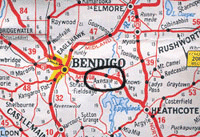
Specifications for the MkII included 500kHz to 30MHz frequency coverage, CW, SSB an AM, 1uV sensitivity (all modes), less than 50Hz drift after warmup, -6dB bandwidths of 1.2kHz (Sharp), 2.2kHz (Medium) and 4.0kHz (Broad). It included a Lamb Noise Silencer and a 100kHz marker generator. The Wadley Loop design was the equivalent of 30 crystal-locked converters and was also used in the well-known Racal receiver - and the FRG7 in latter years.
All items shown here above the chassis are original. The audio amplifier is shown at bottom left and near its top right corner is the marker generator. The centre of the chassis carries the tuneable IF. The 4 coil cans at bottom right are the 40MHz bandpass filter, the small circuit board nearby is the 1MHz crystal oscillator and harmonic generator. The 3 coil cans to its left is the 37.5MHz bandpass filter. The chain driven air spaced capacitor is for the 40.5MHz to 69.5MHz 2nd VFO driven by the front mounted vernier. The Eddystone dial mechanism is in the middle of the front panel connected to the tuneable IF capacitor and the top left in this image shows the trimpots mounted on the S-meter. The power supply transformer is mounted in the centre rear of the chassis.

Component count was very high. It included an expensive but very nice Eddystone 898 dial for the 1MHz tuneable IF, a vernier dial with a Meccano chain and sprocket for selecting the 1MHz range to be presented to the IF, 36 transistors, 3 toggle switches, 4 rotary switches, a single 1MHz crystal, 3 pcb's, 17 tag boards, 7 tag strips, 14 ferrite transformers, 13 coil formers, 13 ceramic resonators, 31 diodes, 169 resistors, and 163 capacitors - give or take a few.
There were a number of functional modules described in the magazine in the lead-up to the MkII and I think this contributed to the multiplicity of tag strips and tag boards that became part of the final design. I often thought how nice, and time consuming, it might be to re-design it using all printed circuit boards. But then it wouldn't be original, would it?
The top right shows the RF amplifier, beside it is the input attenuator and, below that, is the 40.5MHz to 69.5MHz 1st VFO. The central, partitioned, compartment below these contain the 1MHz crystal oscillator and its 0-32MHz low pass filter. To the left of this compartment is 1st Mixer and the 40MHz +/-650kHz bandpass filter and to the right is 2nd Mixer and the 37.5MHz +/-150kHz bandpass filter. The 3rd Mixer is between them at the bottom.
The power supply is in the bottom left of the right section of the chassis. The white cable takes the final 2MHz to 3MHz tuneable IF signal from the 3rd Mixer to the 4th Mixer and Emitter follower. The tuneable IF and 2nd VFO is mounted back-to-back on a vertical panel.
The two modules for the Lamb Noise Silencer are mounted just to the right of the main dial flywheel, the 3 selectivity filters just to its right and the IF amplifier runs vertically down the right side of the chassis. The AGC stage is mounted near the bottom of this strip. The small pcb near this is an experimental detector that I played around with at some time or other.




 Note: On New Year's Day, 2012, I created the Yahoo Deltahet Enthusiasts Group. Any future Deltahet information, beyond what appears here, will be via that group.
Note: On New Year's Day, 2012, I created the Yahoo Deltahet Enthusiasts Group. Any future Deltahet information, beyond what appears here, will be via that group. Specifications for the MkII included 500kHz to 30MHz frequency coverage, CW, SSB an AM, 1uV sensitivity (all modes), less than 50Hz drift after warmup, -6dB bandwidths of 1.2kHz (Sharp), 2.2kHz (Medium) and 4.0kHz (Broad). It included a Lamb Noise Silencer and a 100kHz marker generator. The Wadley Loop design was the equivalent of 30 crystal-locked converters and was also used in the well-known Racal receiver - and the FRG7 in latter years.
Specifications for the MkII included 500kHz to 30MHz frequency coverage, CW, SSB an AM, 1uV sensitivity (all modes), less than 50Hz drift after warmup, -6dB bandwidths of 1.2kHz (Sharp), 2.2kHz (Medium) and 4.0kHz (Broad). It included a Lamb Noise Silencer and a 100kHz marker generator. The Wadley Loop design was the equivalent of 30 crystal-locked converters and was also used in the well-known Racal receiver - and the FRG7 in latter years. Component count was very high. It included an expensive but very nice Eddystone 898 dial for the 1MHz tuneable IF, a vernier dial with a Meccano chain and sprocket for selecting the 1MHz range to be presented to the IF, 36 transistors, 3 toggle switches, 4 rotary switches, a single 1MHz crystal, 3 pcb's, 17 tag boards, 7 tag strips, 14 ferrite transformers, 13 coil formers, 13 ceramic resonators, 31 diodes, 169 resistors, and 163 capacitors - give or take a few.
Component count was very high. It included an expensive but very nice Eddystone 898 dial for the 1MHz tuneable IF, a vernier dial with a Meccano chain and sprocket for selecting the 1MHz range to be presented to the IF, 36 transistors, 3 toggle switches, 4 rotary switches, a single 1MHz crystal, 3 pcb's, 17 tag boards, 7 tag strips, 14 ferrite transformers, 13 coil formers, 13 ceramic resonators, 31 diodes, 169 resistors, and 163 capacitors - give or take a few.